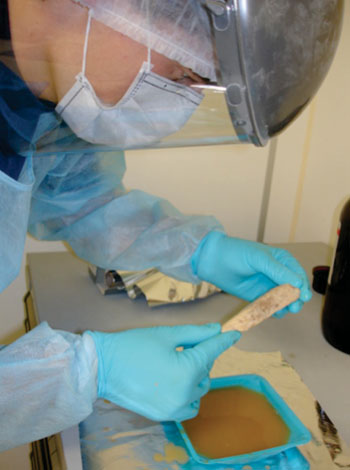Epigenomic Mapping Highlights Differences Between Ancient and Modern Humans
By LabMedica International staff writers
Posted on 06 May 2014
Molecular biologists employing advanced epigenetic techniques have identified genetic differences between Homo sapiens and extinct types of humans such as Neanderthals and Denisovans that are linked to modern diseases like Alzheimer’s disease, autism, and schizophrenia.Posted on 06 May 2014
Epigenomics is the study of the complete set of epigenetic modifications on the genetic material of a cell, known as the epigenome. The field is analogous to genomics and proteomics, which are the study of the genome and proteome of a cell. Epigenetic modifications are reversible modifications to a cell’s DNA or histones that affect gene expression without altering the DNA sequence. Two of the most characterized epigenetic modifications are DNA methylation and histone modification. Epigenetic modifications play an important role in gene expression and regulation, and are involved in numerous cellular processes such as in differentiation/development and tumorigenesis. Recent advances in high-throughput analytical technology have enabled rapid advances in epigenomic research.

Image: Working in a clean room, researchers at the Max Planck Institute for Evolutionary Anthropology took extensive precautions to avoid contaminating Neanderthal DNA samples - extracted from bones like this one - with DNA from any other source, including modern humans (Photo courtesy of the Max Planck Institute for Evolutionary Anthropology).
The evolution of epigenetic regulation along the human lineage remains largely unexplored. To shed further light on this topic, investigators at the Hebrew University of Jerusalem (Israel) and their colleagues at the Max Planck Institute for Evolutionary Anthropology (Leipzig, Germany) reconstructed the full DNA methylation maps of the Neandertal and the Denisovan by harnessing the natural degradation processes of methylated and unmethylated cytosines.
The investigators reported in the April 17, 2014, online edition of the journal Science that by comparing these ancient methylation maps to those of present-day humans, they had identified nearly 2000 differentially methylated regions (DMRs). Particularly, they found substantial methylation changes in the HOXD cluster that may explain anatomical differences between archaic and present-day humans. Hox genes (from an abbreviation of homeobox) are a group of related genes that control the body plan of the embryo along the anterior-posterior axis. After the embryonic segments have formed, the Hox proteins determine the type of segment structures (e.g., legs, antennae, and wings in fruit flies or the different types of vertebrae in humans) that will form on a given segment.
Additionally, the investigators found that DMRs were significantly more likely to be associated with modern diseases such as Alzheimer’s disease, autism and schizophrenia, suggesting that recent epigenetic changes in brain tissues may underlie some of today's common psychiatric disorders.
The authors concluded by saying, "This study provides insight into the epigenetic landscape of our closest evolutionary relatives and opens a window to explore the epigenomes of extinct species."
Related Links:
Hebrew University of Jerusalem
Max Planck Institute for Evolutionary Anthropology








 (3) (1).png)




